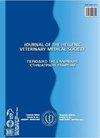不同柑橘品种果皮和果渣的营养价值及体外消化率
IF 0.4
4区 农林科学
Q4 VETERINARY SCIENCES
引用次数: 0
摘要
评价了金柑橘、天堂柑橘、网状柑橘、柠檬柑橘和中华柑橘的农工副产物的营养价值和体外消化率,并对其饲料改性潜力进行了评价。通过化学分析评价其营养价值,采用ANKOM Daisy II培养箱法测定其体外消化率。在p>0.05下,5种柑橘副产物的营养价值差异无统计学意义。农工副产物酚类物质含量差异显著。果皮的体外消化率与果渣显著不同(p<0.001)。这5种柑橘的副产品有潜力作为反刍动物饲料的非草料能源。柠檬副产品蛋白质含量高,但作为单一蛋白质来源不足,而苦橙渣具有抗氧化能力和高消化率。柑橘的丰富农工业副产品、营养价值潜力和消化率使其成为反刍动物饲料改良和利用的良好策略。本文章由计算机程序翻译,如有差异,请以英文原文为准。
Nutritive value and in-vitro digestibility of peels and pomaces of different citrus species
The nutritive value and invitro digestibility of agro-industrial byproducts of Citrus aurantium, Citrus paradisi, Citrus reticulata, Citrus limon and Citrus sinensis were assessed for their feed modification potential. Nutritive value assessment was done through chemical analysis while the ANKOM Daisy II incubator method was used to determine the invitro digestibility. At p>0.05, there was no statistical significance for nutritive value of the citrus byproducts for the five species. The agro-industrial by-products had significantly different phenolic content. Invitro digestibility of the peels significantly differed from the pomaces (p<0.001). The byproducts of the five citrus species showed potential to be considered as non-forage energy sources in ruminant feed. Lemon byproducts had high protein but not sufficient as a single protein source while bitter orange pomace may be considered for antioxidant capacity and high digestibility. Abundance of citrus agro-industrial byproducts, nutritive value potentials and their digestibility makes it a good strategy for ruminant feed modification and utilization.
求助全文
通过发布文献求助,成功后即可免费获取论文全文。
去求助
来源期刊

Journal of the Hellenic Veterinary Medical Society
VETERINARY SCIENCES-
CiteScore
0.60
自引率
0.00%
发文量
83
审稿时长
>12 weeks
期刊介绍:
The Journal of the Hellenic Veterinary Medical Society (J Hellenic Vet Med Soc) is a quarterly peer-reviewed journal that publishes articles in all aspects of veterinary science and related disciplines. It is published by the Hellenic Veterinary Medical Society and is indexed in the Web of Science and in Scopus.
There are no publication fees in the journal. Authors considering submitting manuscripts for evaluation and publication are requested to read carefully the instructions for authors and fully comply with them.
Non-complying manuscripts may be returned to the corresponding author for formatting.
 求助内容:
求助内容: 应助结果提醒方式:
应助结果提醒方式:


